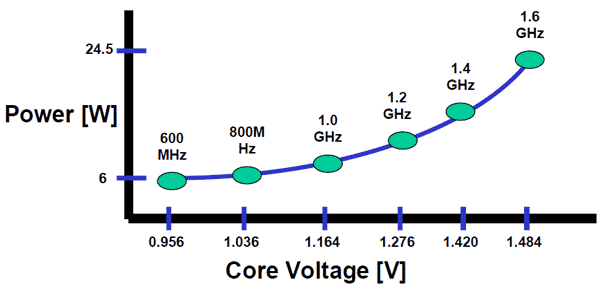SpeedStep and all

We all know that energy is not cheap and is not common everywhere. And, as they say, the further, the worse, that’s why all of humanity is concerned about its economy. Approaches to this economy are very different, here windmills, electric cars, and universal accounting of everything and everything, and much more - the main thing is that the driving gear goes everywhere. Manufacturers of digital devices are also not lagging behind the trend, and in some ways they are even ahead of them, at least, the results in this area are more substantial and more real than in others. To see this, let's talk about the technologies of energy saving in Intel processors.
The word "energy saving" first appeared in the Intel specifications at the end of the last century, when the SpeedStep technology for mobile Intel Pentium III processors was announced, which provided for the possibility of lowering the processor frequency during its inactivity. Initially, in the first version of SpeedStep, there were only two working frequencies - normal and reduced. Accordingly, there were two indicators of heat dissipation and power consumption.
Further, the evolution of SpeedStep followed the path of complicating the processor power circuits. The more advanced technology Enhanced Intel SpeedStep (EIST) already operated with several intermediate points between the maximum and minimum possible processor frequencies, and in addition to the frequency, the voltage applied to the processor also changed. The EIST schedule for a memorable Pentium M processor can be seen in the figure below.

As you can see, the processor frequency was increased by quanta at 200 MHz, while its TDP varied from 6 to 24.5 watts.
For SpeedStep to work properly, it needs support from the motherboard (or, more precisely, its BIOS) and the operating system. Management of consumption modes is carried out from the BIOS or the corresponding OS settings menu. The fact that SpeedStep really works can be verified with the help of utilities that show the actual current frequency of the processor, for example, CPU-Z.
Beginning with the Pentium M, no fundamental changes have occurred at EIST, there is a constant adjustment for each new generation of processors, which has its own, differing indicators of operating voltage, natural frequency and frequency of the central bus FSB. Let's say the Intel Core 2 Duo processor can vary its frequency from 1.6 to 2.8 GHz with an increment of 266 MHz.
However, SpeedStep is not the only one that saves energy in Intel processors. Other technologies are also used, for example, Ultra Fine Grained Power Control, which allows you to disable those processor modules that are inactive at the moment. It is curious that even if the processor as such is very heavily loaded, it still has idle sections that can be turned off if desired.
')

The working moment of the processor. Green shows idle areas.
Another processor frequency manipulation tool is Intel Turbo Boost Technology. The principle of its operation is directly opposite to SpeedStep: the frequency of the processor does not decrease, but increases above the nominal frequencies within its capabilities, which are indicated in the specification. Each processor supporting Turbo Boost is labeled approximately like the following: 7/7/9/10, where the maximum number of increment portions is shown through the dash (for Sandy Bridge processors, for example, the increment is 100 MHz), which can be added while all four cores are working , three two and one respectively. Thus, if the base frequency of the processor is 2500 MHz, then the maximum, taking Turbo Boost into account, will be 2500 + (10 × 100) = 2500 + 1000 = 3500 MHz.

Controlling the SpeedStep and Turbo Boost functions in the BIOS
At first glance, Turbo Boost does not look like a system of energy saving, but in fact it is just that, since the increase in consumption due to an increase in frequency is often marginally compensated by a decrease in the execution time of the task.
Another important front for dealing with excess

Reduced process technology + microarchitecture optimization = energy efficiency
A new milestone on the way to a brighter saving future will be the next Intel Haswell microprocessor microarchitecture, which we will see embodied in silicon in 2013. The Haswell processor lineup will consist, as usual, of the desktop and mobile versions, but a special version for ultrabooks (with the U index) will be added to them. New processors for PCs and laptops consume 20% less compared to the Sandy Bridge family. Of particular interest is Haswell U, which is a single-chip solution with an integrated I / O controller and on-board voltage regulator, which will allow controlling this voltage more accurately and faster. Intel emphasizes that in sleep mode (with the ultrabook lid closed), it consumes 20 times less energy than its predecessors.
As we see, with each new generation of the Intel processor, more and more third-party elements are absorbed. From the point of view of energy efficiency, this is undoubtedly a blessing, since it reduces overall costs. What will we optimize when the processor reaches an extremely small technological process and collects all the electronics of the motherboard inside? Surely, some options will remain even in this case.
Source: https://habr.com/ru/post/155261/
All Articles